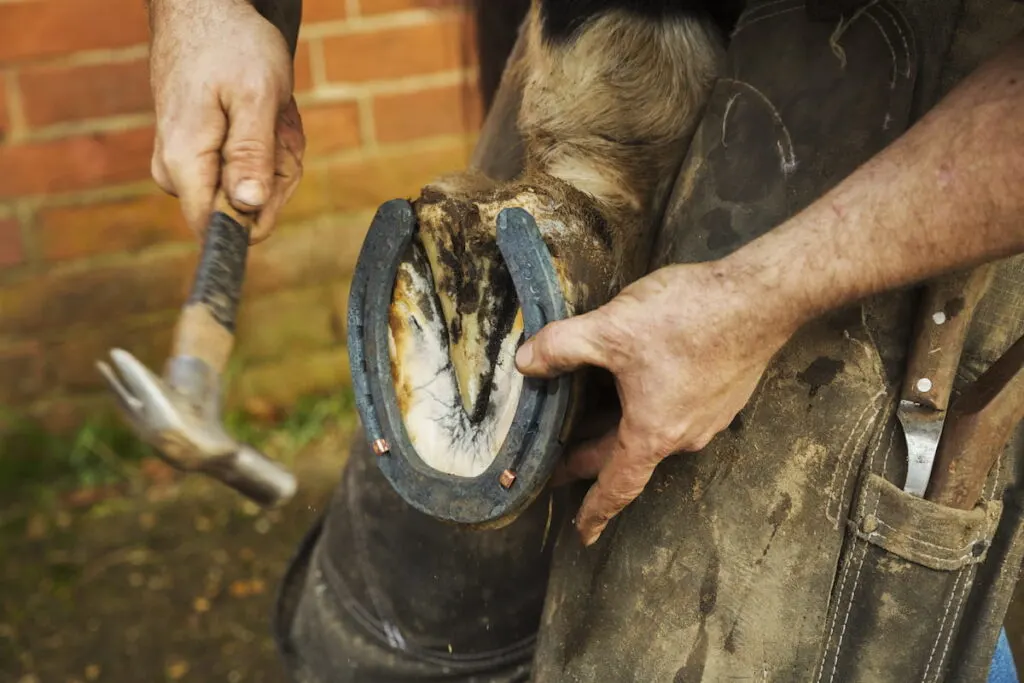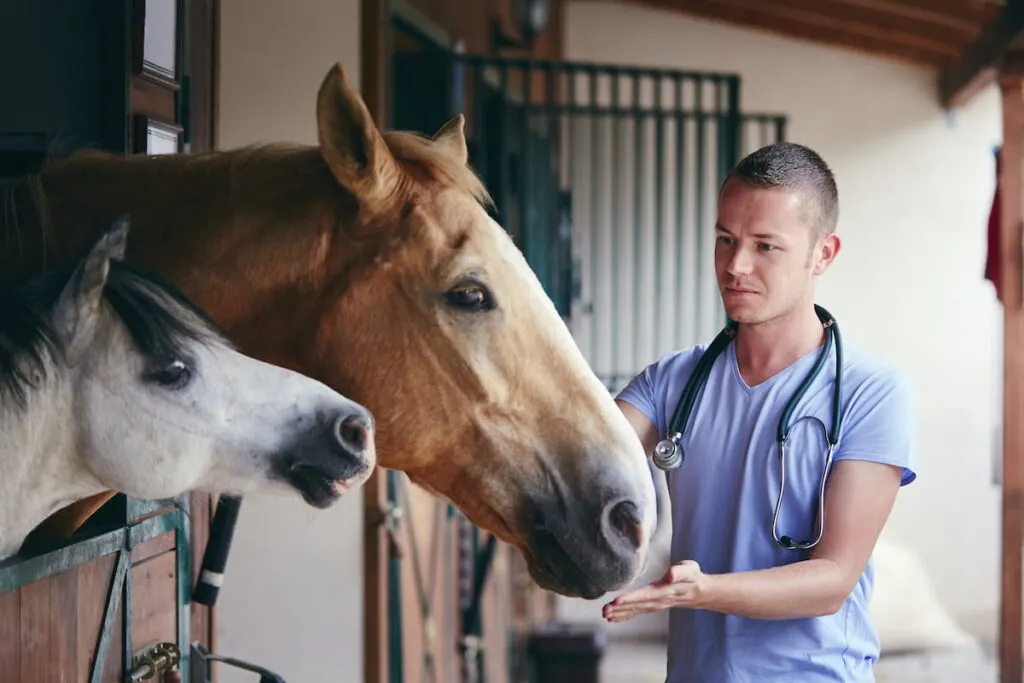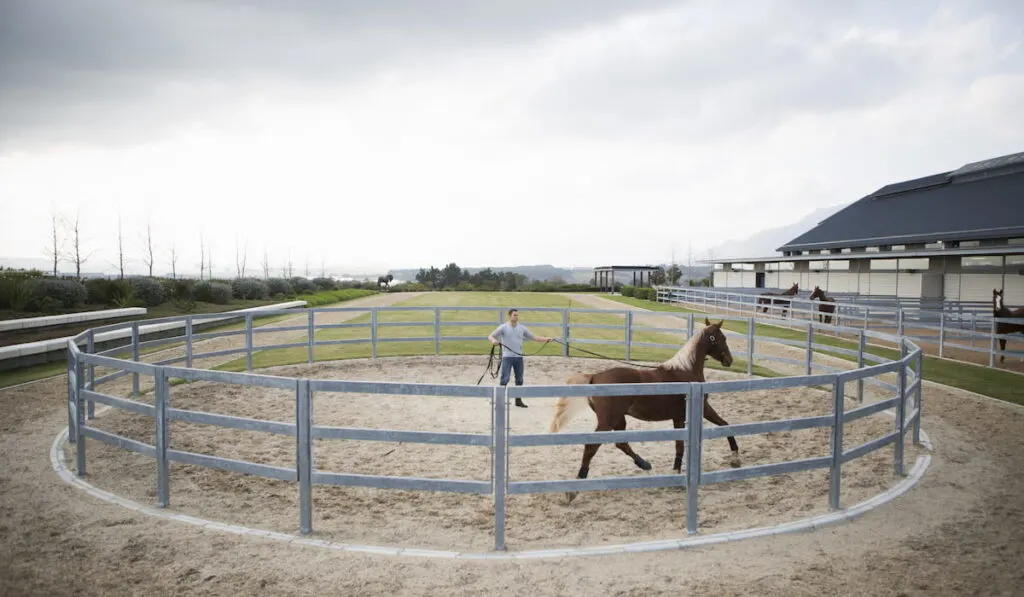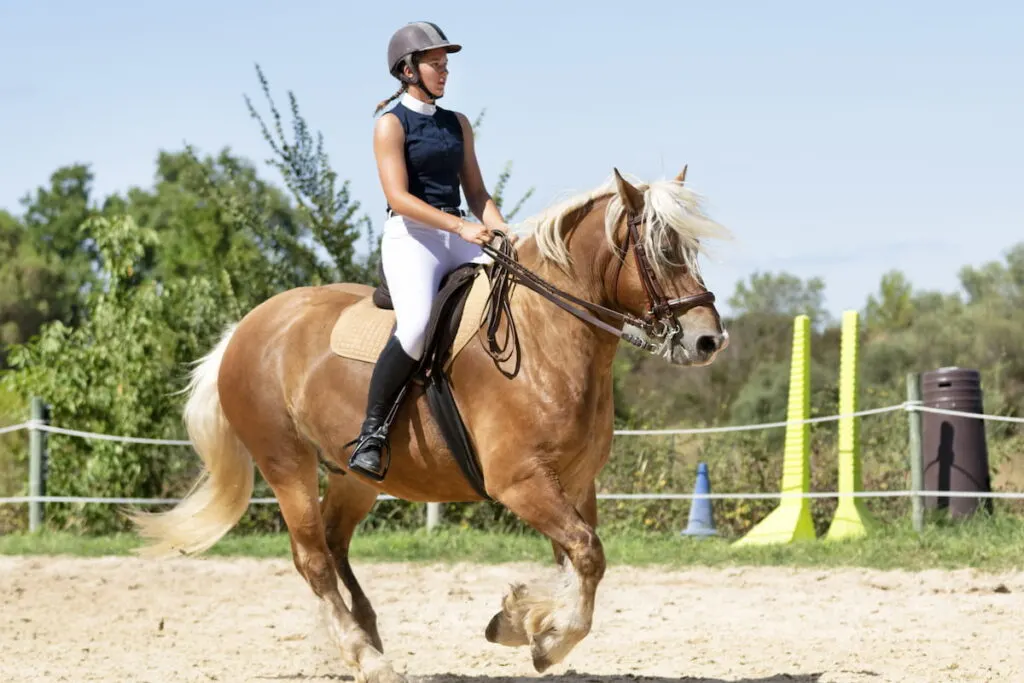As professional riders, we are often called in to help private owners with the issues they’re experiencing with their young horses. In the majority of cases, these problems are avoided or mitigated through correct training and husbandry. This guide is based on a few of the questions our clients have asked us over the years.
A holistic approach to raising horses is the best way to ensure your young horse becomes a healthy, well-balanced adult. Correct nutrition and exercise are essential to meeting a horse’s physical needs.
A horse also needs routine farrier and dentistry care. Horses must always be kept with other horses.
Raising horses is not for the faint-hearted. Many people, myself included, love watching their foals playing in the field, dreaming about riding their homebred youngster. However, horses in general, and foals in particular, are accidents waiting to happen (at least that’s what my vet ruefully claims).
Understanding what your young horse needs to be healthy is the first step to getting your precious baby through to adulthood.
Table of Contents
What Should I Feed My Young Horse?
Young horses are fed 2.5% of their mature weight. No one knows precisely what their horse’s adult weight will be, so we use an estimate of what we think the horse should weigh when grown.
Your young horse’s nutritional requirements are met through eating a combination of roughage (60% to 95%) and concentrates (40% to 5%).
Concentrates are any grain or processed food designed to have high energy, protein, and mineral content.
Your young horse should have a body condition score of 5 to 6 when using the Henneke Body Condition Tool.
Can I Make My Horse Grow Taller By Feeding Them More Food?
Correctly feeding a young horse is the first step in ensuring they remain healthy and receive all the nutrients needed to grow correctly. Horses grow at different rates, with heavy draft horses maturing slower than light breed horses.
Typically, a horse with a mature weight of 1000 pounds will be approximately 64% of its adult height at a year old. By 18 months, your horse will be at 77% of its mature height and 86% at two years old.
Most equine nutritionists agree that adequate nutrition is needed to ensure a horse will achieve its genetically dictated height. Malnourished or undernourished horses will remain small even though their genetic height is much taller. A horse’s growth cannot be influenced once the bony growth plates have closed.
What Are The Nutritional Requirements Of Young Horses?
| Nutrient | 4 months | 6 months | 12 months | 18 months | 24 months | 36 months |
| Milk (Kg) | 0.84 | 0.72 | NA | NA | NA | NA |
| Digestible Energy (MCal) | 13.3 | 15.5 | 18.8 | 19.2 | 18.7 | 23.2 |
| Crude Protein (g) | 669 | 676 | 846 | 799 | 770 | 768 |
| Lysine (g) | 28.8 | 29.1 | 36.4 | 34.4 | 33.1 | 33.0 |
| Calcium (g) | 39,1 | 38.6 | 37.7 | 37.0 | 36.7 | 35.0 |
| Phosphorous (g) | 21,7 | 21.5 | 20.9 | 20.6 | 20.4 | 21.0 |
| Magnesium (g) | .,6 | 4.1 | 5.4 | 6.2 | 6.7 | 11.5 |
| Potassium (g) | 10.9 | 13.0 | 17.4 | 20.2 | 22.0 | 32.0 |
| Sodium (g) | 4.2 | 5.0 | 6.9 | 8.0 | 8.8 | 17.8 |
| Chlorine (g) | 15.7 | 20.1 | 26.5 | 32.0 | 35.4 | 53.3 |
| Sulphur (g) | 6.3 | 8.1 | 12.0 | 14.5 | 16.1 | 16.9 |
| Cobalt (mg) | 0.2 | 0.3 | 0.4 | 0.5 | 0.5 | 0.6 |
| Copper (mg) | 42.1 | 54.0 | 80.3 | 96.9 | 107.3 | 112.5 |
| Iodine (mg) | 1.5 | 1.9 | 2.8 | 3.4 | 3.8 | 4.0 |
| Iron (mg) | 210.6 | 269,9 | 4015 | 484.4 | 536.5 | 450.0 |
| Manganese (mg) | 168.5 | 215,9 | 321.2 | 387.5 | 429.2 | 450.0 |
| Selenium (mg) | 0.42 | 0,54 | 0.80 | 0.97 | 1.07 | 1.13 |
| Zinc (mg) | 168.5 | 215,9 | 321.2 | 387.5 | 429.2 | 456 |
| Vitamin A (kIU) | 7.6 | 9,7 | 14.5 | 17.4 | 19.3 | 22.5 |
| Vitamin D (IU) | 3740 | 4793 | 5589 | 6161 | 5880 | 3300 |
| Vitamin E (IU) | 337 | 432 | 642 | 775 | 858 | 900 |
| Thiamine (mg) | 12.6 | 16.2 | 24.1 | 29.1 | 32.2 | 46.3 |
| Riboflavin (mg) | 8,4 | 10.8 | 16.1 | 19.4 | 21.5 | 22.5 |
| *1 Kg = 2,20 Lbs *1 g = 0,00220 Lbs = 0,0353 oz *1 mg = 0,00000220 Lbs = 0,0000353 oz |
Table 1: The daily nutritional requirements for a young light breed horse with a mature weight of 1102lbs (500kgs), doing no work (Source)
Feeding Horses Is Confusing, Where Can I Get Help?
You can analyze your young horse’s feed by either doing bloodwork to see what they are deficient in or by analyzing the nutritional content for the roughage fed to your young horse.
The results from these tests are then compared to the minimum requirements outlined in the table above. You can either add concentrates and supplements or change the type and quantity of roughage fed based on what you find.
It’s easy to feel overwhelmed when formulating a feeding plan for your young horse. Consulting with an equine nutritionist will assist you in avoiding the feeding mistakes many new horse owners make.

Does My Young Horse Need A Farrier?
Your young horse should be seen by a farrier every four to six weeks. As your horse grows, its limbs and hooves may start to develop incorrectly. Most young horses should not wear shoes unless they are doing strenuous work on hard surfaces, like 2yr old racehorses.
The farrier will assist with maintaining the correct hoof balance and shape. If the farrier notices issues developing with the hoof and leg, they can fix these alignment issues.
Once the growth plates are fused, the window of opportunity to correct these problems is closed. Farrier work after skeletal maturity focuses on maintaining the hoof shape and alleviating symptoms.
Does My Young Horse Need To See A Dentist?
Horses do not need to see a farrier in their first year of life unless there is a problem. Between 2yrs and 3yrs old, your young horse should see a dentist at least once, although a dentist visit every six months would be even better.
During the first three years of your horse’s life, they will gradually lose their baby teeth and grow a complete set of adult teeth. During this period, many teeth issues can arise including, retained caps, impacted teeth, the eruption of wolf teeth, and tooth abscesses.
Call your vet and dentist if your horse starts:
- Dropping their feed
- Starts salivating (slobbering) excessively
- Loses weight and condition
- Starts pacing and biting at their sides
- Develops diarrhea or starts colicking
Your horse should see a dentist before being fitted with a bit. The dentist will create a bit seat in the horse’s mouth and remove any sharp teeth like wolf teeth.
Does My Young Horse Need To See A Physiotherapist?
Many owners of top sport horses will get a physiotherapist or chiropractor out to treat their young horses every month or every second month.
Private horse owners and small non-commercial studs do not need to follow this practice. These studs and owners monitor their youngsters and only call a physiotherapist out when necessary.

How Do I Know When To Call A Vet For My Horse?
The best piece of advice I ever received on monitoring my horse’s health counseled me to recognize what is normal for my horse.
This very experienced and patient horseman said I must know the answer to four questions:
- What does my horse normally behave like in the paddock?
- What is my horse’s average temperature?
- How much does my horse normally eat and drink?
- What does my horse usually look like, i.e., alert, shiny, fat, dopey, etc.?
If I know the answer to those questions, I will quickly and easily spot when something is different. If this is a bad difference (e.g., your alert hyperactive youngster now looks sleepy and unreactive), then don’t hesitate to call your vet.
It is best to be cautious with horses and treat medical issues during the early stages. Medical problems can quickly escalate and become very difficult or even impossible to treat.

What Training Does My Young Horse Need?
I love training young horses; they have an infectious positivity and charming wide-eyed innocence.
However, this does not mean it is all sunshine and roses. Young horses will often test the boundaries of polite behavior, they can be a bouncing ball of uncontrollable energy, and occasionally, they have the same appeal as rebellious, opinionated teenagers.
Each interaction with your young horse is, in essence, a training session. Your responsibility is to ensure your horse learns to trust humans, enjoys work, and has polite manners.
Training From Birth To 12 Months
Training during this period focuses on getting the horse comfortable with all activities occurring within the stable yard. Your foal and weanling should be easy to catch, halter, lead, tie, and groom. During this stage, 5-to-10-minute sessions are sufficient.
Training From 1yr to 3yrs
This stage in your horse’s life is the perfect time to start exposing them to activities outside the yard. An adequately prepared and mannerly yearling can begin learning how to load into and travel in a horsebox.
Your yearling will also benefit from learning to pony from an older, more experienced CALM horse. Once your yearling has mastered this skill, it can start going on short outrides with you and your older horse. It allows them to gain confidence as they see and experience all the sights and sounds typical to trail riding.
You can also start introducing basic bombproofing exercises to create a well-rounded horse that can regulate its fear response. This training should never scare your horse. Instead, bombproof training should help build your horse’s trust in you and his confidence in himself.
Training From 3yrs to 4yrs
You can now start in-hand and lunge work aimed at preparing your horse for a ridden career. Each new exercise and piece of equipment is introduced slowly and carefully.
You should only move on to the next step once your horse has fully mastered the previous step and can perform it in a relaxed manner. Most horses easily accept the rider IF all the fundamentals are firmly in place.
Can I Do The Training Myself Or Do I Need A Professional Trainer To Help With Training?
There are three options available for training your horse:
- Do all the training yourself
- Do most of the training yourself under the guidance of a trainer
- Let a trainer do all of the training
If you are a novice horse owner and rider, I would advise against doing all the training yourself. The potential for injury to you and your horse is exceptionally high.
If you have an easy horse but are unfamiliar with training young horses, the best option is number 2. This option allows you to learn the correct methods and outcomes for training while enabling you to bond with your horse and acquire new skills.
Option three is perfect for three situations:
- You don’t have time to focus on a young horse, e.g., you’re pregnant or at university and can’t concentrate on a youngster for the next year or so.
- You have significant health issues and cannot risk being injured
- You have a challenging youngster who is technically very difficult.
When considering which option will be the best for you, it is essential to be realistic about your skill level, the difficulty of your particular youngster, and how much time you can consistently commit to training.

When Can I Start Riding My Horse?
This is the first question every client asks me! Horses are generally mature enough to be ridden between 3yrs and 5 yrs of age. Drafts and slow maturing breeds need longer to mature before being ridden and are often only ready at 5yrs.
Fast maturing breeds like Arabs and Quarter Horses are ridden much younger. Western riders and racehorse trainers back horses between 18 months and 2yrs. However, there is significant controversy around this issue relating to skeletal maturity, long-term soundness, and bone density.
Can My Young Horse Live Alone?
All equines are social creatures and should never be kept by themselves. As prey animals, they rely on their fellow equines to keep them safe while grazing and sleeping. Horses who live by themselves will develop abnormal behaviors due to stress and sleep deprivation.
The social structure of a herd allows youngsters to learn good horse behavior. We often get youngsters in for training who have truly atrocious behavior.
The first thing we always do is put them out in our gelding or mare herds. The older horses do at least 50% of the work in teaching rude youngsters to be polite.
Playing with other youngsters is perfect for teaching your youngster the mental, physical and social skills they need to be a well-balanced horse.
Conclusion
Raising horses is an art as much as it is a science. A holistic approach to raising horses is the best method for ensuring your horse grows into the horse you know it can be.
A horse’s physical requirements are met by addressing its nutritional, farriery, dentistry, and medical needs.
Training is a life-long process that begins at birth. It is your responsibility to foster your relationship with your horse and to set your horse up for success by helping them master a comprehensive set of skills relating to human-horse interactions.
I cannot sufficiently emphasize how important other horses are to the success of rearing your youngster. Your youngster will learn more from other horses than they will ever learn from humans. Young horses kept in herd environments are more confident, relaxed, and balanced than horses kept alone.
Resources
- https://thehorse.com/136769/feeding-young-horses-graduating-to-a-grown-up-diet/
- https://www1.agric.gov.ab.ca/feeding-young-horses.pdf
- https://forageplus.co.uk/feeding-the-young-horse/
- https://www.nap.edu/read/11653/chapter/18#299
- https://www.habitatforhorses.org/the-henneke-body-condition-scoring-system/
- https://evds.net.au/tips-and-info/dental-problems-in-young-horses
